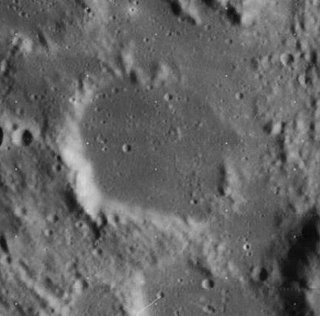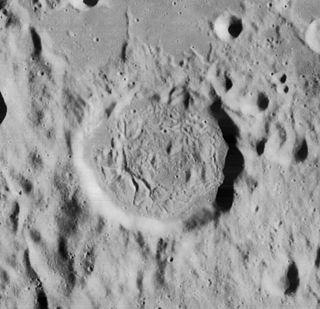
Dembowski is a lunar impact crater located to the southeast of the Sinus Medii. Its diameter is 26 km. It was named after Italian astronomer Ercole Dembowski. To the east are the craters Agrippa and Godin, to the southwest is Rhaeticus.

Chladni is a small lunar impact crater that lies near the northwest edge of Sinus Medii, in the central part of the Moon. The crater is named for German physicist and musician Ernst Chladni who, in 1794, wrote the first book on meteorites. The rim of the crater is roughly circular, and there is a small central floor at the midpoint of the sloping inner walls. This feature has a higher albedo than the surrounding terrain. It is connected by a low ridge to the rim of the crater Murchison, which lies to the northwest. Due east of Chladni is the larger Triesnecker.

Sharp is a lunar impact crater located to the west of the Sinus Iridum bay of the Mare Imbrium, beyond the Montes Jura range. To the southwest is the crater Mairan. Because of its location and foreshortening, Sharp appears elliptical from the earth.

Cavalerius is a prominent lunar impact crater that lies on the western edge of the Oceanus Procellarum lunar mare on the west part of the visible Moon. It nearly joins the northern rim of Hevelius to the south.

Herschel is a lunar impact crater located just to the north of the walled plain Ptolemaeus. Its diameter is 39 km. It was named after German-born British astronomer William Herschel.

Le Verrier is a small lunar impact crater located in the northern part of the Mare Imbrium. It was named after French mathematician and astronomer Urbain Le Verrier. To the west is the slightly larger crater Helicon, and farther to the west-northwest lies the mountain-ringed bay Sinus Iridum.

La Condamine is a small lunar impact crater that is located on the southern edge of the Mare Frigoris, in the northern part of the Moon. It lies to the northeast of the mountain-rimmed Sinus Iridum formation in the northwest part of the Mare Imbrium.

Helicon is a small lunar impact crater that is located on the north part of the Mare Imbrium. The crater was named after 4th century BC Greek astronomer Helicon of Cyzicus, a friend and disciple of Plato. To the northwest is the prominent Sinus Iridum, a mountain-ringed bay on the mare. Just to the east is the slightly smaller crater Le Verrier.

Boss is a lunar impact crater that is located along the northeast rim of the Moon's near side. Due to its location, the crater is viewed from the side by observers on the Earth, and its visibility is subject to libration effects. It was named by the IAU in 1964 for astronomer Lewis Boss.

Blanchinus is a lunar impact crater in the rugged south-central highlands of the Moon. It is named after Italian astronomer Giovanni Bianchini whose Latinized name is Blanchinus. Adjacent to its south is the crater Werner, and La Caille is attached to the northwest rim. To its west is the prominent formation Purbach.

Fizeau is a prominent lunar impact crater that is located on the far side of the Moon, in the southern hemisphere. Nearby craters of note include Minkowski to the west-northwest, and Eijkman to the southwest.

Brisbane is a lunar impact crater that is located in the southeastern part of the Moon, to the south of the crater Peirescius. To the northwest lie the craters Vega and Reimarus, and farther to the east is the walled plain Lyot. Due to its proximity to the limb, foreshortening of this crater causes it to appear somewhat elliptical in shape, even though it is actually circular.

Conon is a small but prominent lunar impact crater that lies in the eastern foothills of the Montes Apenninus mountain range. The crater is named for the Greek astronomer Conon of Samos. Just to the west of Conon is the long mountainous ridge Mons Bradley. The nearest craters possessing an eponym are Galen, about 70 kilometres (43 mi) to the east, and Aratus, about the same distance to the northeast.

Demonax is a lunar impact crater near the southern limb of the Moon. This location makes the crater difficult to observe due to foreshortening. The crater is also illuminated at a very low angle, when it is in the sunlit side. Demonax lies just to the north of the crater Scott, one of the south polar formations. To the north-northwest is Boguslawsky.

Carnot is a large crater in the northern part of the Moon's far side. It was named after Nicolas L. S. Carnot by the IAU in 1970.

Dyson is a lunar impact crater, 63 kilometers in diameter, that lies on the far side of the Moon, past the northwest limb. It is located in the northern part of the surface, to the northwest of the crater Coulomb, and east of van't Hoff.

Louville is a lunar impact crater that is located on the western edge of the Sinus Roris, a bay in the northern part of the Oceanus Procellarum. It lies to the northwest of the crater Mairan, on a triangular section of continental terrain to the west of Sinus Iridum and the Mare Imbrium.

Fourier is a lunar impact crater that is located in the southwestern part of the Moon's near side, just to the southeast of the crater Vieta. To the northeast is the Mare Humorum. The rim of this crater is roughly circular, but appears oval when viewed from the Earth due to foreshortening.

Fraunhofer is a lunar impact crater that is located just to the south-southwest of the walled plain Furnerius, in the southeastern part of the Moon. This crater appears foreshortened when viewed from the Earth, and is actually nearly circular.

Finsen is a lunar impact crater that is located in the southern hemisphere, on the Moon's far side. It is attached to the southeastern exterior of the walled plain Leibnitz, and the ejecta from Finsen covers the southeastern part of Leibnitz's interior floor. To the southwest of Finsen is another walled plain, Von Kármán, partly overlain by Leibnitz.






















